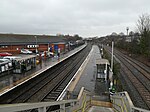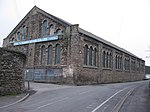The Great Western Cotton Factory
19th century in BristolCotton industry in EnglandDefunct companies based in BristolDefunct manufacturing companies of the United KingdomEngvarB from June 2017 ... and 5 more
Industrial Revolution in EnglandManufacturing companies based in BristolSlavery in the United StatesTextile mills in EnglandWorks of Isambard Kingdom Brunel

The Great Western Cotton Factory was opened on a site in Barton Hill, Bristol in April 1838 (1838-04) to spin and weave cotton into cloth. The cotton processed at the factory was brought from America to the port of Liverpool and carried by water to Bristol. It was the only example of a cotton mill in the south west of England, most other factories being in Lancashire, Yorkshire, Cheshire and Derbyshire.
Excerpt from the Wikipedia article The Great Western Cotton Factory (License: CC BY-SA 3.0, Authors, Images).The Great Western Cotton Factory
Maze Street, Bristol Redfield
Geographical coordinates (GPS) Address Nearby Places Show on map
Geographical coordinates (GPS)
| Latitude | Longitude |
|---|---|
| N 51.452821 ° | E -2.562899 ° |
Address
Maze Street
Maze Street
BS5 9RD Bristol, Redfield
England, United Kingdom
Open on Google Maps








